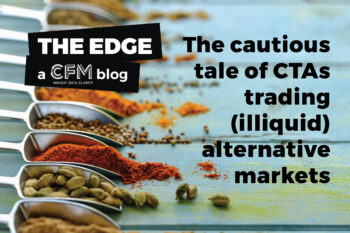This article was first published in the Pensions & Investments on 8 May 2023 here.
Macro factors always affect financial markets, but the extent of their influence varies. It is fair to say that we are in a period when such factors are dominating investor sentiment.
For plan sponsors, this creates headaches for asset allocation. How can they construct sound portfolios when so many macro concerns — inflation, monetary policy, potential recession, market volatility, political partisanship, geopolitical risks — are pulling investors in many different directions?
Philip Seager, head of Absolute Return at Capital Fund Management (CFM), believes that global macro strategies potentially offer the return and diversification benefits that can help institutional portfolios in the current environment — and in any other environment, for that matter. CFM’s research has found that, “Historically, global macro tends to perform relatively well regardless of the big picture, including in the kind of conditions investors face now. It’s an all-weather strategy that should have a permanent place in any large portfolio,” he said.
WHAT IS GLOBAL MACRO?
Seager defined global macro as a strategy based on the belief that a specific scenario will unfold and drive activity across markets worldwide. Most frequently, these scenarios are economic, financial or geopolitical. Global macro strategies have the flexibility to invest across asset classes and geographies, as well as to go long and short.
There are two main global macro approaches: discretionary and systematic. The discretionary approach involves a fundamental investor developing a scenario and placing a fairly small number of high-conviction bets. By contrast, the systematic approach — followed by CFM — employs quantitative, rules-based methods that analyze voluminous data to arrive at a scenario and then makes many lower-conviction bets. The two approaches are complementary, according to Seager, and they have historically generated similarly robust performance patterns across market regimes.
A GENUINE DIVERSIFIER
“Diversification is the only free lunch in investing.” That is a quote attributed to Nobel laureate Harry Markowitz. If he was right, then global macro should be considered fine dining because its returns are uncorrelated with those of traditional assets such as equities, fixed income and currencies.
As Seager put it: “Global macro is a genuine diversifier because it can go long and short, trades across asset classes and can focus risk on the markets where opportunities are greatest. We don’t agree with the idea that private markets provide true diversification; instead, we find that they’re essentially a leveraged version of traditional assets that adds illiquidity risk, [as well as] volatility that’s hidden because positions aren’t marked to market. Global macro is unique in that it invests in traditional assets, but its returns aren’t correlated with them.”
WHY NOW?
A recent CFM report* makes a strong case for investing in global macro now. The report states that the macro drivers of 2023 are the same as in 2022 — a period in which global macro significantly outperformed traditional assets and most hedge fund strategies.
Inflation: Inflation remains the biggest macro cloud hanging over markets. While its pace in the U.S. has subsided since peaking in mid-2022, it is still much higher than the Federal Reserve’s 2.0% annualized target level and continues to affect Fed policy decisions more than any other factor. It is even more elevated in Europe, where both the European Central Bank and the Bank of England have aggressively raised their respective benchmark rates.
CFM studied the returns of multiple asset classes and hedge fund strategies during periods of above- and below-trend inflation. Macro strategies were among the top performers under both conditions, which is consistent with the firm’s belief that global macro is among the strategies best positioned to capture dispersion across regions and inflation-sensitive asset classes.
Monetary policy: Similar to its inflation analysis, the report looked at the performance of multiple asset classes and hedge fund strategies during periods when the Fed cut and raised U.S. rates. As with inflation, macro strategies generated attractive returns in both environments.
Seager said that the current differences in monetary policy among the world’s major central banks should prove fruitful for global macro investors. “You’ve got the extremes of the U.S. and the EU which are fighting inflation, all the way to the other extreme in Japan, which is still focused on quantitative easing and yield-curve control. One could argue that China is in need of stimulating rather than tightening as well. This sort of dispersion across the geographies creates a lot of opportunities for the global macro approach.”
Recession: There is a wide spectrum of opinion about the potential for a recession in the U.S., U.K., continental Europe or globally. In addition, there is considerable disagreement over when a recession could begin, how deep it could get and how long it could last.
According to the CFM report, global macro strategies have performed well , not only generating positive returns in recessionary periods, but they also outperformed fixed income during economic expansions.
Political and geopolitical risks: U.S. political partisanship in the House and Senate is at or near historical highs based on analysis of multiple data sources, the report says. This is meaningful for investors because higher levels of partisanship are seen as a negative drag on economic growth and policymaking generally. The report additionally notes that geopolitical risk is hovering near its own record highs.
“Together with inflation and moderating economic growth,” Seager said, “political and geopolitical risks create a macro tinderbox of sorts. Even a small spark will likely generate and exacerbate [the] volatility that’s already quite high. Global macro strategies can exploit this information, and they stand to benefit from the resulting increases in volatility and dispersion.”
AVOID THE ‘ATM’ TRAP
Ironically, global macro’s success can lead to the reduction of its allocation size in times of market stress. The reason, Seager explained, is that it is highly liquid.
“When equities take a hit, as they did in the financial crisis and 2022, institutional investors rebalance their portfolios to reduce their equities exposure. They’ve taken a loss and need to free up some cash; so they go to the most liquid assets in their portfolio, which include global macro strategies. Macro ends up being used like an ATM, an easy place to access cash. In this strange way, global macro tends to get redemptions despite the fact that it [does] well.”
“We call this the ATM trap,” he said. “Allocating to global macro on an ongoing basis is well worth the commitment, both in terms of performance and diversification.”
Global Macro
Seager described a bright future for global macro, driven by the explosion in analyzable data and the ubiquity of algorithms in daily life. “In the future, we think algorithms are going to dominate,” he said, “purely because the amount of data in the world is only going one way, which is up, and it’s never going to stop growing. To keep up with that growing amount of data, we believe that algorithms and systematic trading will have a competitive advantage. They’re better suited to absorbing, analyzing and interpreting the vast amount of data. Humans can’t compete with that.”
In daily life, he continued, “certain jobs and daily tasks require algorithms to such an extent that they can’t be done without computers. Imagine getting on an airplane and the captain announces that ‘the computer is down, so I’m going to fly the plane manually and hope everything works out for the best.’ No passenger would want to be on that plane! Why should investing be any different?”
*2023 and Beyond: An Enduring Case for Global Macro Strategies, February 2023, CFM.
Any description or information involving investment process or allocations is provided for illustration purposes only. There can be no assurance that these statements are or will prove to be accurate or complete in any way. This article does not constitute an offer or solicitation to subscribe for any security or interest
Disclaimer
Any description or information involving investment process or allocations is provided for illustration purposes only. There can be no assurance that these statements are or will prove to be accurate or complete in any way. This article does not constitute an offer or solicitation to subscribe for any security or interest.



